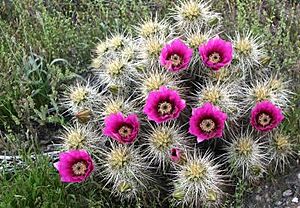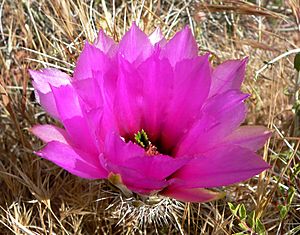Echinocereus engelmannii facts for kids
Quick facts for kids Echinocereus engelmannii |
|
|---|---|
 |
|
| Conservation status | |
| Scientific classification |
The strawberry hedgehog cactus, also known as Engelmann's hedgehog cactus (Echinocereus engelmannii), is a cool plant found in the deserts of the southwestern United States and nearby parts of Mexico. You can spot it in places like California, Nevada, Utah, Arizona, and the Mexican states of Baja California and Sonora. It's called "hedgehog" because its spiky stems look a bit like a hedgehog!
Contents
About the Strawberry Hedgehog Cactus
This cactus usually grows in groups, sometimes with more than 20 stems. Its bright pink-purple flowers bloom in spring, from April in warmer areas to late May in cooler northern spots. These flowers are shaped like funnels and can be up to about 9 centimeters (3.5 inches) long. They have dark green parts inside where the seeds are made.
The fruit of this cactus is spiky. At first, the fruit is green, but it turns pink and dries out when it's ready. When the fruit is ripe, its spines can easily come off. The seeds inside are black and tiny, about 2.5 millimeters (a tenth of an inch) big.
Stems and Spines
When the plants are young, their stems are round and stand straight up. As they get older, the base of the stem might lie on the ground. The stems are usually about 4 to 9 centimeters (1.5 to 3.5 inches) wide and can grow up to 63 centimeters (25 inches) tall. They are often hidden by many thick spines. Each plant usually has about 10 ribs, which are a bit flat and bumpy.
The spines on the cactus come in different colors and sizes. The shorter spines, called radial spines, are like needles. They are up to 2 centimeters (0.8 inches) long, white, and arranged in a neat circle. The longer, thicker spines, called central spines, are usually twisted and can be up to 7.5 centimeters (3 inches) long. They can be bright yellow, dark brown, gray, or white.
Where It Lives
The strawberry hedgehog cactus is one of the most common types of cactus in the southwestern USA and Mexico. It grows in many dry places, especially in deserts like the Sonoran and Mojave deserts. You can find it in areas with good drainage, such as sandy plains, dry riverbeds, canyons, and rocky hillsides. It can grow from sea level up to about 2,400 meters (7,900 feet) high.
This cactus is very common where it grows. Sometimes, changes to the land can affect these cacti, but it's not a big problem for them right now.
How People Use It
The Echinocereus engelmannii is sometimes used as a plant in gardens in the areas where it naturally grows. If you want to grow this cactus in a pot, it needs soil that drains very well and a hot, sunny spot in the summer. During winter, it can handle a little bit of frost and wet soil, as long as the soil doesn't stay soggy. When grown in a pot, this cactus usually won't bloom until it has grown 2 or 3 branches.
See also
 In Spanish: Echinocereus engelmannii para niños
In Spanish: Echinocereus engelmannii para niños



